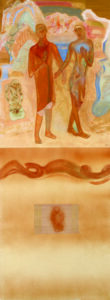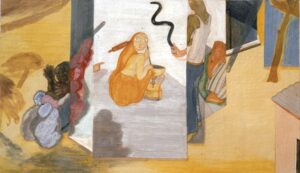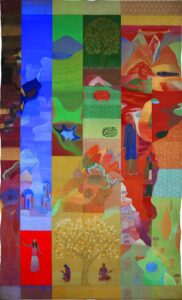Currently Empty: ₨0.00

Nilima Sheikh earned international acclaim in 1984-1985 for the delicately constructed series ‘When Champa Grew Up,’ a narrative series which told the tragic tale of a woman murdered for her dowry money by her husband’s family, in twelve frames. Sheikh has since built up a repertoire of sensitive work that dwells on her own experiences and immediate environs, as well as commentaries on collective history and tradition, human situations and gender issues. Using traditional tempera and casein techniques she makes paintings that demonstrate a deep relationship with drawing and colour to produce poetic visualisations of the mundane and the fantastic. Having inherited a concern with traditional art forms from her teacher K.G. Subramanyan, she has developed a practice that is as experimental as it is grounded in its uses of technique.
Born in 1945 in an undivided, pre-independent India, at New Delhi, Nilima Sheikh studied history at the Delhi University (1962-65) and painting at the Faculty of Fine Arts, Baroda (1971). She joined the faculty and taught painting there between 1977 and 1981. Since she held her first solo exhibition in New Delhi in 1983, she has shown her work widely, nationally and internationally. Her work has straddled many traditions, from the Japanese Ukiyo-e to Rajasthan, Pahari and Mughal miniatures and the oral tradition found in vernacular folk songs. Her work also harks back to Asian traditions of painting from China, Tibet and Sri Lanka and to the primal bonding between art and craft.
Her practice has embraced various kinds of painting, from the hand-held miniature to larger-than-life size creations at an architectural scale, and from conventionally framed paintings to scrolls and screens for the theatre stage. Nilima’s artistic lineage also draws from her connection with the celebrated artist Gulammohammed Sheikh, once her teacher at Baroda, and later her husband. Her habit is to create works in a cyclical way, as in the calendric series of the narrative of Song-Space, she explains, “Maybe I’m uncomfortable with a single piece. I’m constantly trying to resolve that.” Her works, whether based on personal experience or timeless legends like that of Sohni-Mahiwal, encompass the drama of the domestic or the underlying subtleties of human interaction. Inspired early in her career by reading Rabindranath Tagore, the artist became interested in the connection between stories and images. Sheikh continually works with figure and narration in her practice, which has also translated into theatre sets such as the 1993 Vivadi theatre production of ‘Umrao’, and also children’s books.
The artist’s painterly treatment of tempera continued in her practice to increasingly ambitious scales. In 1996, ‘Shamiana’ was a series unveiled at the Second Asia-Pacific Triennial, an installation with six hanging tempera on canvas scrolls, covered with a canopy made of synthetic polymer paint on canvas that referenced a marriage tent. “I started working with tempera on paper in 1982 because my paintings before that were beginning to look like tempera paintings. It seemed necessary to make this shift. I was also getting more interested in the traditions of Indian and Asian painting, which used tempera”…
“Later, I began to enjoy the medium for itself. I mix my colours myself when I work on a large scale. These colours have an intrinsic quality of their own, which gets neutralised by a medium like oil or acrylic. The colour quality remains the same, but the surface qualities tend to get neutralised. But in tempera, a terra-verte would be different from a crimson. An earth colour would be different from a dye colour.” she has explained at length in a media interview.
Sheikh was fascinated by Kashmir since her childhood, but it was not until the 2002 Gujarat riots, which affected her mentally and emotionally, that she was able to directly address her connection with this state. In recent years, her concerns have been more to do with historical dimensions of feminine subjectivity, and also with the transcendental urge in the lament of the lover. Nilima Sheikh produces beautiful paintings about historical and contemporary Indian life, and all of its paradoxes. Her work has inspired several generations of artists over her 50 year career as a Baroda based painter. Sheikh has an unshakeable position in the history of Indian Modern art.
By Lina Vincent Sunish
‘My Hometown’,
80 x 23 inches,
tempera on sanganer paper,
2008
‘Another Chronicle of Loss’,
78 x 23 inches,
tempera on sanganer paper,
2009
‘At a certain point I lost track of you’,
62 x 23 inches,
tempera on sanganer paper,
2008
‘When Champa grew up’, (from series of 12)
22 x 35 cm,
tempera on sanganer paper,
1984 – 85
‘What happened that day 1’,
196 x 59 cm
tempera on sanganer paper,
2008
‘Each night put Kashmir in your Dreams 2’
120 x 72 inches,
scroll painted on both sides,
casein tempera on canvas,
2003
All Nilima Sheikh Images are courtesy of Gallery Espace and the Artist.
Extract from the book ‘ 20 Indo Pak Painters You Should Know’






